

Review by Gokhra
Cast : Frank Martin: Jason Statham, Gianni: Alessandro Gassman, Audrey Billings: Amber Valletta, Lola: Katie Nauta, Mr. Billings: Matthew Modine, Dimitri: Jason Flemyng, Stappleton: Keith David, Jack Billings: Hunter Clary
This happens to be one of the most implausible, unbelievable, ridiculous, over-the-top movies this season. And I simply couldn't wait to see it. It's that good.
The plot:
"Transporter 2" is better than the original for a number of reasons mainly that it has an ingenious plot that continues to twist and turn to reveal surprises and complications well into the last part of the movie. This may be an action flick but its simply not about good guy chasing bad guys and vice versa with some explosions thrown in for good measure. It's actually bloody tricky.
Frank Martin (Statham) used to be an ex military dude who took up a job of delivering things for a fee. He's a bit of a Superman albeit in a black suit instead or blue tights. This sequel begins with the stoic Frank Martin helping out a friend by filling in for a month as the driver and bodyguard for a cute kid named Jack (Hunter Clary), whose dad Jackson (Matthew Modine) heads the United States narcotics agency. But Frank can't avoid trouble and before you can think about kidnapping it happens albeit with the aid of a car bomb. Soon Frank is put into the role of reluctant protector taking the heat from bad guys and femme fatale assassin Lola (model Kate Nauta) who prefers carzy eye makeup and see through bikinis.
The kidnapping takes place in a bizarre and intriguing manner. But the kid is recovered quickly, much too quickly. You get the feeling that it's supposed to go on for longer. As it turns out the kidnapping was just a sub plot for a whole lot of madness. The fact that bad guys can think so far into their evilness and have so many twists and turns is a sign of supreme evil genius.
So what did the kidnapping actually lead to? Well, you gotta watch the movie to find that out. You won't be disappointed unless you are one of those people who scoff at anything out of the ordinary. For you people, go watch some boring award nominated biography.
The verdict:
This is a story about a superhero. I mean, let's face it, only a superhero can do what Stathams character can do and then manage to survive. And it's all utterly ridiculous but immensely fun. You will have a lot of laughs which is of the good kind where you laugh along with the movie and not at it. I know I did.
For example, while being held by the bad guys Frank sees a reflection in a pool of liquid under his car that there is a bomb. That's what puddles are always good for. Knowing that the bad guys will not explode it while they're standing right next to it, the hero races the car out of a garage and up an incline, spinning the car neatly through the air, so that it makes one complete rotation and the bomb is pulled off by a hook on a crane, exploding harmlessly as the car lands safely. Looks immensely cool and if you really think about it in a dazed stupor, you will see that such a stunt is actually doable. Now don't laugh, it is definitely doable in a world where everything can go exactly as you plan. Also you gotta have Lady Luck as your best friend.
Such stunts are preposterous, but the fact is, I laughed aloud. Similarly impossible are stunts such as the one where he uses a jet ski to jump onto a highway and then jump from it into the back of a school bus. Then there's the scene where he leads a police pursuit up the ramps of a parking garage and then crashes his car through a wall of the garage, and it flies a couple of hundred feet through the air to a safe landing.
This is where one of my disappointments lie. So many of these flash stunts have been done using computer imagery as opposed to the original where al was done using meticulously planned real life action. It's a trifle disconcerting to see that the car, an Audi, smashes through a wall with all its headlights and four-ringed badge intact. Heck, is it a supercar? But otherwise everything else was right on target.
Jason Statham plays his hard as nails character to the limit. He's a man who has his emotions so well under control that he can barely be bothered to have any. He's a bit of the anti hero everyone roots for.
It's got elaborate and inspired fight scenes. "The Transporter 2" stands a triumph of stunts over plot although the plot is pretty damn good. It's got huge loads of style although low on substance. At times it is brainless but ultimately terrific fun. It definitely outdoes the original in terms of flair. If you don't enjoy this movie for it's sheer craziness then go watch biographies.

By Adnan M.S. Fakir
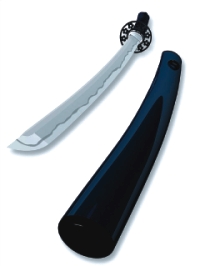 YAH! HAIII! HOO!"… Honestly, I freaked out when my picchi eight-year-old cousin, screaming his lugs out, ended up banging me on my head with a stick pretending to be a samurai. As my head ached and hrobbed with pain, I asked the little fellow what he wanted to be when he grows up… "I want to learn Batto-jutsu and become a Battousai just like Ken-san." (Ken-san refers to Kenshin of the Japanese animation "Rurouni Kenshin" also known as "Samurai X"… watch it, it's about the times of the Japanese revolution with a lot of added masala). I then realized the intense curiosity in most of us, ranging from even the little kids and to grown ups, about the cryptic Japanese sword arts.
YAH! HAIII! HOO!"… Honestly, I freaked out when my picchi eight-year-old cousin, screaming his lugs out, ended up banging me on my head with a stick pretending to be a samurai. As my head ached and hrobbed with pain, I asked the little fellow what he wanted to be when he grows up… "I want to learn Batto-jutsu and become a Battousai just like Ken-san." (Ken-san refers to Kenshin of the Japanese animation "Rurouni Kenshin" also known as "Samurai X"… watch it, it's about the times of the Japanese revolution with a lot of added masala). I then realized the intense curiosity in most of us, ranging from even the little kids and to grown ups, about the cryptic Japanese sword arts.
Frankly speaking when I started to write this article I was hoping to base it more on just weapons… but it ended up to be huge so I decided to cut it into two…
one focusing mostly on the different Japanese sword styles and swords. I am sure many of us here have heard about kenjutsu, kendo, iaido, iaijutsu and all…
but how much do we know about them or even can differentiate them. Well, if you are interested please read on…
The History…(*)
The Japanese culture is heavily imbued with the sword. In fact, one of the three objects of possession required to be Emperor is a sword. This Imperial Regalia has been handed down, generation after generation, to the ruler of Japan; the Jewel, the Mirror, and the Sword. The Imperial Regalia is held in the Shinto shrine at Ise, near the traditional home of the Imperial family Nara. The ancient legend of the Shinto that tells of the origin of the islands themselves refers to a bladed weapon which was dipped into the sea and the drops of water off of the tip became the islands of Japan.
Japanese legend says that the gifted sword maker Amakuni was the one to develop the classically styled Japanese sword: long, single edged and curved with a two handed grip. Amakuni is thought to have lived in about 720 AD. Prior to this time, the swords were developed from copies of Chinese and Korean designs. Straight, single or double edged, and usually two handed grips. Two things happened with the advent of the Japanese style. First, the blade became a very effective cutting weapon, even against armor. And two, its deployment changed which allowed the rise of a distinct style of Japanese Swordsmanship.
What is Kendo and Kenjutsu?
Kendo (also called Kumdo by the Koreans) is the way of the sword - "Japanese fencing". It is taught as part of the school physical education curriculum in Japan! Can you believe it? We all here are sitting ducks! College kendo teams in Japan are high-profile; major competitions are televised complete with explained commentary.
Kendoka (the practitioner of kendo) wear armor protecting the head, throat, wrists and abdomen; these are the only legal targets. The split-bamboo practice sword, called a shinai, is wielded two-handed; the kendoka faces his opponent squarely. A small number of high-level practitioners utilize a shinai in each hand. Kendoka move using a peculiar gliding step refined for use on the smooth floors of the dojo.
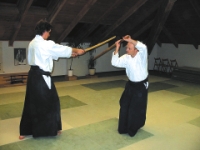 Generally (but not always) in Japanese martial arts, the "do" forms (eg. karate-do) are those used to improve the self, while the "jutsu" forms (eg. kenjutsu) concentrate on teaching the techniques of war. The art of winning real fights with real swords is kenjutsu. The goal of kenjutsu is victory over opponents; the goal of kendo is to improve oneself through the study of the sword. Kendo also has a strong sporting aspect with big tournaments avidly followed by the Japanese public. Thus kendo could be considered the philosophical/sporting aspect of Japanese swordsmanship.
Generally (but not always) in Japanese martial arts, the "do" forms (eg. karate-do) are those used to improve the self, while the "jutsu" forms (eg. kenjutsu) concentrate on teaching the techniques of war. The art of winning real fights with real swords is kenjutsu. The goal of kenjutsu is victory over opponents; the goal of kendo is to improve oneself through the study of the sword. Kendo also has a strong sporting aspect with big tournaments avidly followed by the Japanese public. Thus kendo could be considered the philosophical/sporting aspect of Japanese swordsmanship.
There used to be many kenjutsu ryu (styles); only a handful of them have survived. One of the oldest is Tenshin Shoden Katori Shinto Ryu. There is also Itto Ryu, from which much of modern kendo is derived. In terms of learning to fight with a sword, kenjutsu has a more complete curriculum. Kendo, of necessity, limits the range of techniques and targets. Kendoka generally use shinai, which allow techniques which do not work with real swords. Kenjutsu practitioners do not usually use shinai in training; instead prefer to use bokken (wooden swords) or katana (see later) in order to preserve the cutting techniques of real sword fighting. Kenjutsu training largely consists of practicing cutting techniques and performing partner katas.
Bokken techniques are also taught in aikido dojos (the practice ground) but not every aikido dojo offers qualified instruction in actual sword techniques. Many of them use bokken practice only as a way of better understanding the empty-handed techniques, as these techniques are grounded in kenjutsu.
Then what is Iaido and Iaijutsu?
Iaido is the art of drawing and attacking with a sword, although a more in depth reading of the Japanese characters for iaido results in (very roughly) "the way of harmonizing oneself in action". Iaidoka (and kendoka) wield a sword, ironically, not to control their opponent, but to control themselves.
Iaido is performed solo as a series of kata, executing varied techniques against single or multiple imaginary opponents. In addition to sword technique, it requires imagination and concentration in order to maintain the feeling of a real fight and to keep the kata fresh.
Iaijutsu is the art of killing on the draw. Cool, huh? Iaijutsu teaches how to draw quickly and in such a fashion as to negate an opponent's attack with finality.
Seitei-gata iaido (set of techniques recommended by the ZNKR, the All-Japan Kendo Federation) is like a moving meditation - the draw and cut are very deliberate, formalized and beautiful. It is as far removed from iai-jutsu as kendo is from kenjutsu. Iaijutsu is more direct and forceful, less concerned with the state of the practitioner's mind and more with dispatching the opponent.
Then… then what the hell is batto-jutsu, tameshi-giri, shinkendo and others?
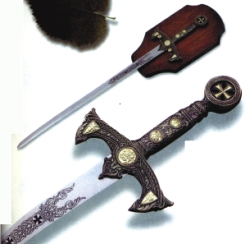 Again, "very generally", batto-jutsu is another word for iaijutsu, tameshi-giri is the art of physically cutting with the sword and shinkendo is fencing from a real sword perspective.
Again, "very generally", batto-jutsu is another word for iaijutsu, tameshi-giri is the art of physically cutting with the sword and shinkendo is fencing from a real sword perspective.
However, hundreds of years ago, the various sword teachers called their arts by various names which all designated more or less the complete curricula of sword technique. In other words, what one ryu called kendo (or iaijutsu, or kenjutsu, or batto-jutsu) in the 15th century is not the same as what we call kendo today - it would have incorporated techniques of fencing, drawing and cutting, with each styles' primary focus as explained earlier. No swordsman would be sufficiently trained without all these three skills.
The Swords!!!
How they make the swords…(*)
Seriously, there are as many as a half-dozen people involved in the construction of a sword.
The sword-smith forges the actual blade. He starts usually with a special kind of traditional Japanese steel called tamahagane, and works with hammer and forge to fold it a number of times. There are two processes in general, one to make core steel (shinganae) and the other to make jacket steel (kawagane). Kawagane is folded more times and ends up being harder and less ductile than shinganae. In the simplest construction, a piece of kawagane is folded around a piece of shinganae to form a jacketed core. Thus the shinganae allows the sword to flex instead of breaking on impact, and the kawagane allows it to take the famous razor edge. More complicated construction methods can produce swords made of as many of 5 pieces of steel, all forged differently.
The folding process is used to closely control the uniformity and carbon content of the steel. An accomplished smith can tell by eye to within a tenth of a percent the carbon content of a piece of steel!
When the basic blank has been constructed, the smith will continue to work what is essentially a metal bar into the shape of the sword. When the forging is done, the blade is the correct length, curvature and general shape, but lacks a finish and certain of the various edges and features. The smith will then use coarse polishing stones to further define the blade before passing it onto the polisher. The polisher brings out the beauty of the smith's art… improperly polished and the blade is ruined.
A woodcarver then makes a saya (scabbard) for the sword. A jeweller makes the habaki, the small but critical metal piece which is constructed to fit exactly on the blade next to the tang, and provide the snug friction fit which keeps the blade from rattling in the saya.
Further craftsmen make the finishings. There can be separate craftsmen for the tsuka (handle), tsuba (handguard) and menuki (hilt ornaments). As you can see, making a true Japanese sword is certainly not a walk in the park!
Classification…
Generally, the swords are classified by length. A daito is a sword with a blade longer than two shaku (1 shaku = approx. 11.9 inches ). A wakizashi is between one and two shaku in length, and a tanto is less than one shaku.
There are lots of other names. The most common one, katana, refers to the style most people have seen; a daito which is worn stuck through the obi (belt) with the edge up. A tachi is an older style of daito, slightly longer and more curved, worn slung on cords with the edge down, usually used in a calvary style. A no-dachi is a bigger tachi, with a very long handle, worn slung over the back for battlefield application. A ko-dachi is a different word for a wakizashi, or short sword. A chokuto, or ken, is a very old style straight sword.
The katana is a curved sword about 90cm long. It is sharp at the point and the convex edge. The crucial feature of the katana is that it is extremely sharp. Sharper than anything you have ever handled. Sharp enough to cut you into two pieces without knocking you over. It is important to keep this in mind in order to understand the ways in which it should be handled.
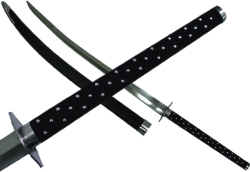 Mostly used swords in practice are the shinai, bokken and iaito. The shinai (mostly used in Kendo) is constructed of 4 pieces of split bamboo. The tip of the shinai is covered in leather; the four staves are held apart by a t-shaped piece of rubber. The handle is round rather than oval like a real katana. The split construction allows the staves to both flex and compress against each other, absorbing much of the energy of the blow. Attacks which miss the amour cause bruises, nothing more. Bokken (used primarily in Kenjutsu) are usually constructed of white Japanese oak, although they can be made of a variety of exotic hardwoods. They are curved and sized like a katana, and the handle is about the same length and oval. Iaidoka at lower ranks use iaito, which are dull katana. A good iaito at the least has a proper handle with ray skin and cord grip and is constructed strongly enough so as not to be a danger in practice. The more expensive an iaito gets, the more closely its construction mirrors that of a good sharp sword, called shinken, the lower graded katanas.
Mostly used swords in practice are the shinai, bokken and iaito. The shinai (mostly used in Kendo) is constructed of 4 pieces of split bamboo. The tip of the shinai is covered in leather; the four staves are held apart by a t-shaped piece of rubber. The handle is round rather than oval like a real katana. The split construction allows the staves to both flex and compress against each other, absorbing much of the energy of the blow. Attacks which miss the amour cause bruises, nothing more. Bokken (used primarily in Kenjutsu) are usually constructed of white Japanese oak, although they can be made of a variety of exotic hardwoods. They are curved and sized like a katana, and the handle is about the same length and oval. Iaidoka at lower ranks use iaito, which are dull katana. A good iaito at the least has a proper handle with ray skin and cord grip and is constructed strongly enough so as not to be a danger in practice. The more expensive an iaito gets, the more closely its construction mirrors that of a good sharp sword, called shinken, the lower graded katanas.
I guess it's too much information in just one article but I really hope it has been useful to you. If any of you by the minutest of chances have a shinken/katana that you guys want to sell at a considerably low price…
please send a mail to [email protected]...
*Reference book used: Japan and the Sword, by Sasabaki Tsume

Review by Le Chupacabra
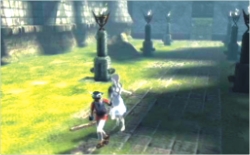 The story of ICO is rather incomprehensible. Throughout the game there will be hints and glimpses but nothing more. Ico is a boy born with horns and according to village folklore this is a sign of impending doom. Ico is thus locked away in a fortress-prison for all eternity. A sudden earthquake helps him break free of his chamber and taking this chance, he sets out to escape. In the process he discovers an ethereal young woman - a princess - who has been imprisoned. Mysterious shadow creatures try to capture her and it is then that the valiant Ico steps in to save her. Thus begins a story lovingly crafted around the relationship of Ico and Yorda, both on either side of an impenetrable language barrier, yet bound by mutual trust and a simple desire: freedom.
The story of ICO is rather incomprehensible. Throughout the game there will be hints and glimpses but nothing more. Ico is a boy born with horns and according to village folklore this is a sign of impending doom. Ico is thus locked away in a fortress-prison for all eternity. A sudden earthquake helps him break free of his chamber and taking this chance, he sets out to escape. In the process he discovers an ethereal young woman - a princess - who has been imprisoned. Mysterious shadow creatures try to capture her and it is then that the valiant Ico steps in to save her. Thus begins a story lovingly crafted around the relationship of Ico and Yorda, both on either side of an impenetrable language barrier, yet bound by mutual trust and a simple desire: freedom.
The game tasks you with an objective that is simple to follow but difficult to accomplish: escape. You must traverse the gargantuan castle as you look for a path to freedom. Each area only leads to another and each open window seems to dare you to go further. While the game can be classified as a puzzle title, the experience is simply more than what words can describe. Each 'puzzle' is seamlessly and organically integrated into the environment and really gives you an opportunity to put your brain to work. There isn't any complex math logic; all you have to do is let your mind wander and a little imagination and lateral thinking does wonders. The feeling of accomplishment you get after solving any puzzle is incredible. Not only does it fill you with a sense of immense and genuine satisfaction but it fuels your hope and drives you to keep going.
Once you figure out how to pass a certain area, you must now help Yorda. Since she is slightly impaired of mobility, it's upto you to arrange a safer path for her. You may think that it's an inconvenience to be babysitting someone in game, but in Ico you'd be wrong. The game creates this bond between the player and the characters you see. As Ico starts to care more about Yorda, so do you. In return, Yorda's trust in Ico grows. It's a subtle effect yet one that'll immerse you in a way that you can't describe. Yorda will slowly take risks she never would have taken in the beginning. When I played the game for the first time, I was pretty careless and allowed the shadow creatures to capture Yorda many times. When it came to this jump, Yorda didn't trust me and it took a long time to convince her to jump. Rather than feeling annoyed, I felt guilty since it was my duty to protect her. The next time I played, I made sure I wouldn't make the same mistake. That time, Yorda jumped the second I called her. True, she never made the gap but somehow she grabbed Ico's outstretched arm at the last moment and I was able to pull her to safety. It's moments like these when your heart really pounds and you're constantly worried that she might not make it the next time. For a game that has none of the ubiquitous 'trust' or 'fear' meters of current games, the way that ICO evokes such emotion is something that I've yet to experience in a video game. While there is some combat it boils down to hitting away at these weird shadow creatures which attempt to kidnap Yorda and take her down into some dark void. Sequences like these have you fighting not for your sake, but to protect Yorda. Not only is it because you have to, it's also because you want to.
The look and appeal of the environs in Ico are astounding. The ethereal graphics of ICO give off this enchanting feeling of timelessness. For the first time, everything not only looks real but it actually feels so! Each building doesn't seem to be made of polygons or textures; instead it looks like it was hewn out of stone and brick. Each room is dark, dreary and enormous; it really dampens the spirit. You'll feel rightfully dwarfed every time! Light is used beautifully. It filters through the small windows and accentuates the darkness you have to traverse through. In open areas it strongly illuminates everything with a radiance that is otherworldly. If you've ever read Harry Potter and know what a Pensieve is, then the shadow creatures of this game are a visualisation of the strange mist in the Pensieve. While they look to be made of nothing but dark smoke they feel corporeal and alive at the same time. Everything you see will never feel out of place, and combined with the fact there is no life bar, the game immerses you and will never break that sense till you actually finish the game.
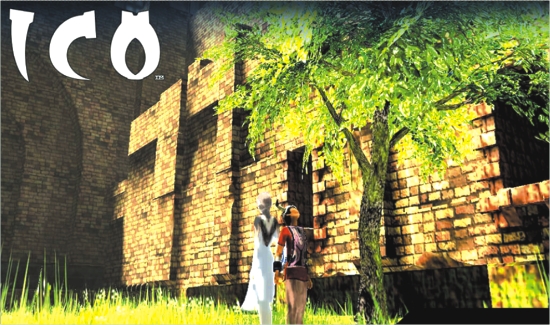
The music in Ico is minimalistic and given the nature of the game and the way it is presented, it's a perfect choice. The light melodies combined with select guitar chords enhance the evocation that this game so carefully attempts to accomplish.
Ico is like a dream; it's an experience that always appears to be tangible but is still enigmatic beyond words. Ico will provoke a myriad of emotions within you in a way that's its simply indescribable. Honestly, very few people will play this game, but those who do and are willing to complete the journey will have experienced something only a dream can offer…
Comments, suggestions, flames and hate mail can all be directed to: [email protected]
